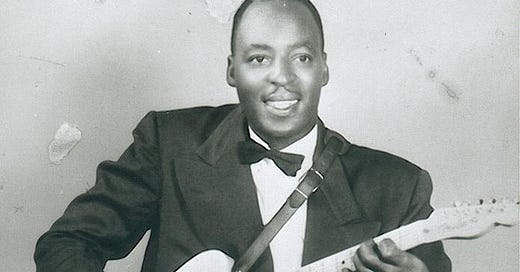Killer Blues Guitar! A Dozen Electrifying Postwar Obscurities, 1947-1952
Some of the Most Visceral Guitar on Record
Due to rationing and material shortages, few blues records were made during World War II. Soon afterward, the widespread availability of magnetic tape recording machines allowed enterprising entrepreneurs to create independent record labels. Radio stations and jukeboxes gave them a means to promote their wares. Dozens of blues specialty labels sprang into existence.
At this time the electric guitar was still in its ascendency. A swath of blues musicians young and old began plugging in, cranking up, and pioneering new sounds. In the process, they brought a new vibrancy to the blues. Listed in chronological order, the dozen tracks presented here were originally compiled by Klaus Kilian, for a CD set that was never issued. Thank you, Klaus, for the superlative selections!
All of these tracks were recorded by small, independent labels between 1947 and 1952. They showcase some of the wildest, most visceral guitar ever recorded. Have mercy!
Wright Holmes, “Good Road Blues,” 1947
Born in Hightower, Texas, in 1905, Wright Holmes recorded his first records for Goldstar in 1946. The label withheld them from release, claiming they sounded too much like Lightnin’ Hopkins, who’d just made his first records. The following year Holmes made his final four recordings, three of which came out on Gotham.
Holmes accompanied his hip singing with ultra-imaginative guitar playing that’s notable for its sheer abandon, unfettered soloing, and boogie bass lines that would reappear on early rockabilly records. He sounds like he’s playing an acoustic guitar outfitted with a soundhole pickup. His amp tubes must have been glowing!
Muddy Waters, “Burying Ground,” July 12, 1949
Muddy opens this performance with one of his patented moves: big, low-string slide swoops. On an earlier version recorded for Columbia in 1946, Waters had cut “Burying Ground Blues” with guitarist Homer Harris, drummer Judge Riley, and pianist James Clark. On this version, Muddy let Clark do the lion’s share of the soloing.
The following year Waters signed with Chicago-based Aristocrat Records and began recording with string bassist Ernest “Big” Crawford, who provided the perfect accompaniment for Muddy’s amplified Delta blues. During July 1949 the duo recorded “Burying Ground,” drawing heavily from the Mississippi Delta blues of Waters’ youth. The song’s heartbreaking theme may well have been inspired by the musician who’d tutored Muddy on guitar, Son House. On his 1930 Paramount release “My Black Mama, Part 2,” House sang:
“I got a letter this morning, how do you think it read,
Hurry, hurry, the gal you love is dead”
With its low-string slides, sure-handed turnarounds, and treble zings, “Burying Ground” is far tougher-sounding than the earlier ensemble version. Muddy injects what would become one of his trademark solos into this take, bottlenecking the sonic equivalent of angry, swarming bees.
Keep reading with a 7-day free trial
Subscribe to Talking Guitar ★ Jas Obrecht's Music Magazine to keep reading this post and get 7 days of free access to the full post archives.



